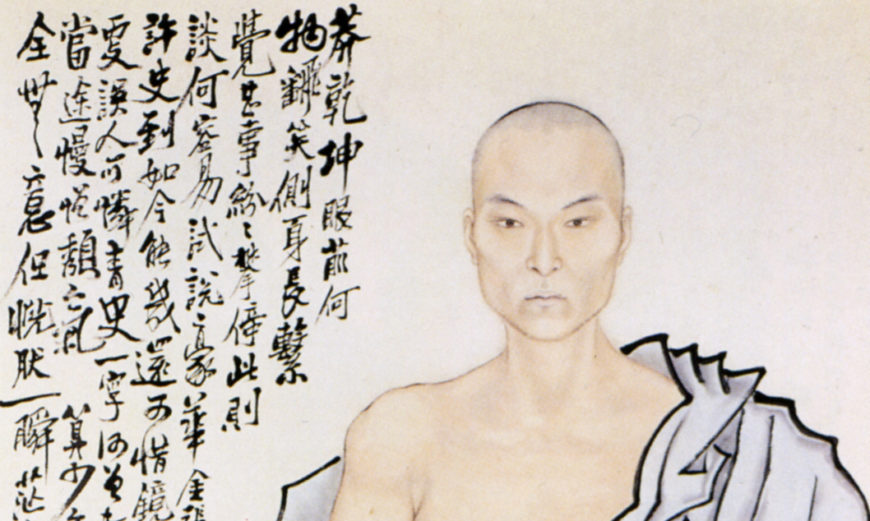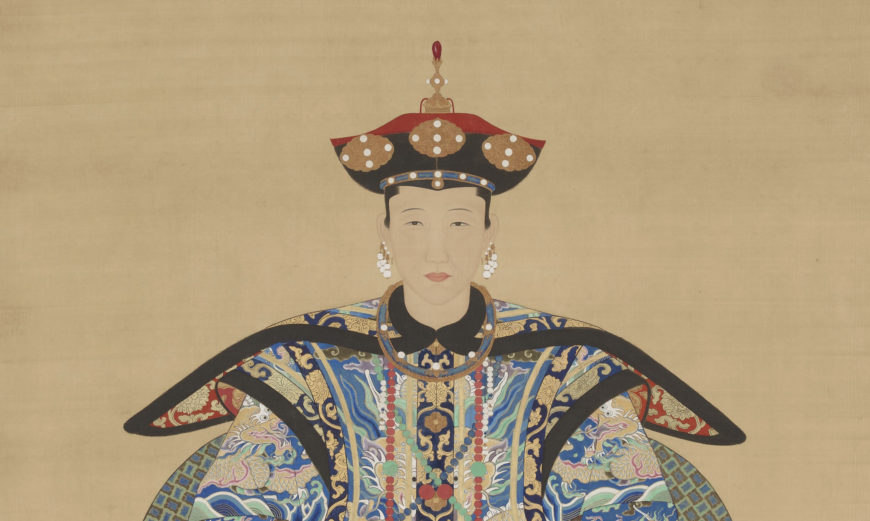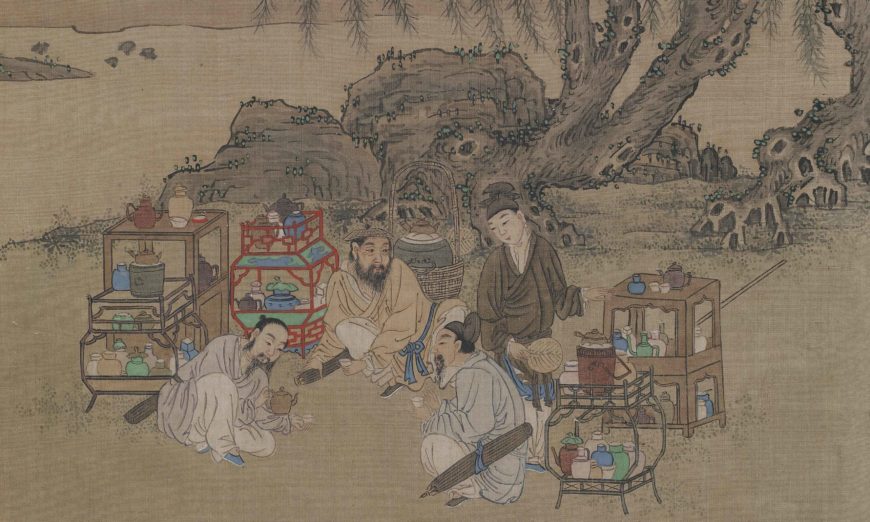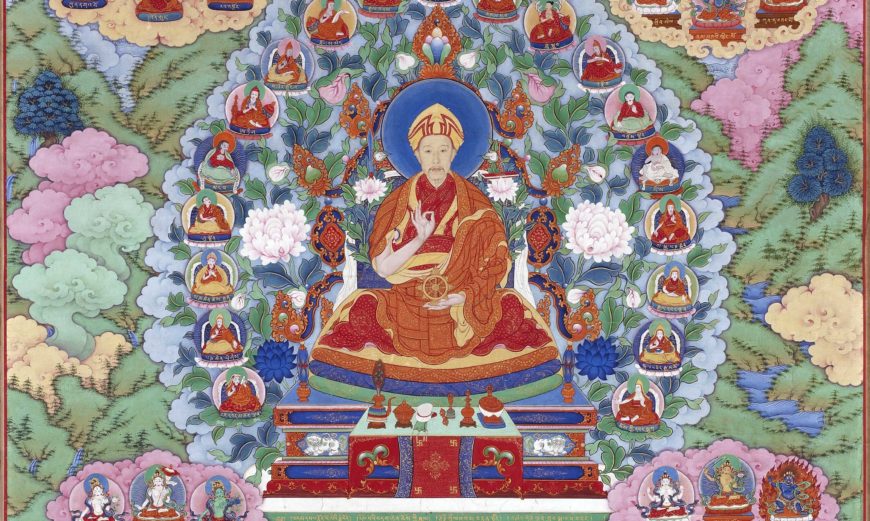Hua Yan, Pheasant, Bamboo and Chrysanthemum, hanging scroll, 18th century, Qing (1644–1911), ink and color on paper, 106.8 x 47.2 cm (Shanghai Museum, China)
[0:00] [music]
Dr. Steven Zucker: [0:03] Here we are, looking at a mid-18th-century hanging scroll painting that seems to me, at first glance, to be pretty garish.
Dr. Kristen Loring Brennan: [0:14] That’s a great word for describing it. It’s bright and we’ve got a golden pheasant.
Dr. Zucker: [0:18] Despite the fact that he’s really red.
Dr. Brennan: [0:20] He has a tuft of gold on his head and a wisp of gold feathers on his tail, but the body itself is red and some touches of blue on the wings. This bird with his mouth open seems to be calling out.
Dr. Zucker: [0:31] And regal. And probably very attractive to the newly wealthy merchant class of the 18th century.
Dr. Brennan: [0:37] This was in a city called Yangzhou, a city that was bustling, that was the seat of the salt administration in the 18th century on the Grand Canal in the lower Yangzhou River, so it was a very important area for trade.
Dr. Zucker: [0:50] By salt administration, you’re talking literally about mineral salt.
Dr. Brennan: [0:53] Yes.
Dr. Zucker: [0:53] And the way in which salt was distributed and taxed. It was a commodity that produced real wealth in this area.
Dr. Brennan: [0:59] This was the gatekeeper for the Grand Canal route between Beijing and Hangzhou.
Dr. Zucker: [1:03] You have this city with this wealthy merchant class, and then you have artists that are producing works of art that would be attractive for them.
Dr. Brennan: [1:10] When we talk about the Yangzhou School, it doesn’t mean they all came from Yangzhou. Hua Yan, this artist in particular, was from a place called Hangzhou. He was originally from somewhere even farther, Fujian province, and he was an itinerant artist. He moved to these different areas seeking patronage.
Dr. Zucker: [1:24] He was extremely skilled. There is subtlety here, and real understanding of the extraordinary history of Chinese painting. Look, for example, at the way in which elements in the bird are found in the landscape around him.
[1:36] There’s the beautiful turn of his long, elegant tail feathers, and look at the bend of the bamboo and the way that it’s echoed; or look, for example, at his talons, and the way in which there’s a small branch just in front that almost looks like a third foot, or the way in which the yellow tuft or the red tail feathers mimic the chrysanthemum about halfway up the painting on the right.
Dr. Brennan: [1:57] You can see the variation in the brushstrokes. We’ve got meticulous strokes depicting this bird, making it almost a caricaturized expression on its face, in contrast with the splashy treatment of the garden rock, the bamboo, which is in all kinds of gradations, black, gray, and light strokes splashed across the upper quadrant of the painting.
Dr. Zucker: [2:17] We have this enormous variety of skills, and it’s clear that this artist had tremendous technical facility. I’m especially in love with the very wet quality of the ink towards the lower right.
Dr. Brennan: [2:28] The expressiveness, this flavor of spontaneity, was associated with literati in the past. This idea of the expression of the brush, the art of the line, and the fact that that had the capability of expressing one’s emotions.
Dr. Zucker: [2:42] That is in such contrast to the very fine rendering of the bird. And perhaps one of the reasons that the bird feels somewhat out of place; you see the tension in this artist between needing to satisfy a specific market, and also wanting to show his skill and his sophistication.
Dr. Brennan: [2:57] We see that even in his inscription, this is somebody who has studied poetry, has studied painting history, and really is capable in all of these ways. He’s added an inscription here, which is actually a poem.
[3:10] The poem itself reads, “Wind strokes roaming feathers / Relaxing its brocaded embroidery / Bamboo turns at ease in the shadows / Braving the cold morning.”
[3:21] When we think about that poem, we also see who he might have been painting for. There’s no named recipient. We have a signature of the artist here.
[3:30] But judging from the brushwork, the colors, the composition, the poem, this is something that might be attractive for its literary refinement. Something that’s alluring to a patron who might want something auspicious for his wall, something that suggests his own literary refinement.
Dr. Zucker: [3:47] The word for pheasant in Chinese is very close to the word for auspicious.
Dr. Brennan: [3:52] Yes.
Dr. Zucker: [3:53] There is symbolic value here.
Dr. Brennan: [3:55] The golden pheasant itself is supposed to be a bird that is not enticed easily by food.
Dr. Zucker: [4:00] He couldn’t be bought. The bamboo has references to the scholarly pursuit, the chrysanthemum to the isolation of the artist, having drawn themselves away from the everyday world to a world of refinement.
Dr. Brennan: [4:12] Or the politician who has a humble abode in the country. That’s also what the gardens symbolized, this idea of getting away from it all. In Yangzhou, lots of new gardens were being built by all these patrons.
Dr. Zucker: [4:23] I have a new respect and appreciation for this pheasant, who is here a symbol of the auspicious. A symbol of this extraordinary Chinese tradition now in the modern world.
[4:32] [music]






